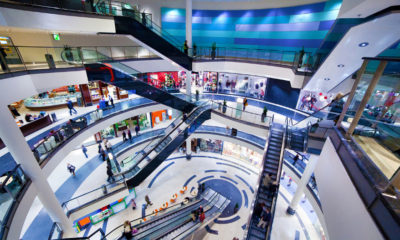I may end up becoming the resident “mall expert” at VMSD, considering my odd passion for this subject. If you know me, you know I’m obsessed with dead malls. I think it stems from my love of urban exploration and the beauty one can find in deteriorated, forgotten places, especially those that resemble time capsules. In a documentary about ailing shopping centers, one of the founders of deadmalls.com likened the feelings dead malls give him to the idea of being so small next to something so big; that even when a building like that is “dead,” you still sense its larger-than-life presence.
Recently I visited my hometown mall in Dayton, Ohio, which is doing well, unlike many of its peers that house primarily mid-priced retailers. Of course, Elder-Beerman’s is on its way out, and Sears just announced it will close its location there in November, but there is hope of finding replacement anchors (it will still have four anchors after Beerman’s and Sears exit).
Luxury malls like Kenwood Towne Center in Cincinnati are extremely busy. I’m not exaggerating when I say you have to dodge mobs of shoppers every corridor you walk, even if you visit on a weekday morning at 11 a.m. It is always packed, rain or shine. Similar to the semi-enclosed luxury Bal Harbour Shops in Bal Harbour, Fla., its tenants are high end. The main difference at Kenwood is that it’s home to a small mix of mid-priced stores – for example, Lacoste, Kate Spade, Anthropologie, H&M, Forever 21 and Victoria’s Secret all have residency there. Yet both malls are at or near 100 percent occupancy – Bal Harbour has reportedly been 100 percent occupied since its opening in 1965!
Regardless, there are hundreds of mid-priced or discount malls across the country facing potential closure. Some are hanging on for dear life, like the Forest Fair Village (formerly known as Cincinnati Mills, Cincinnati Mall and Forest Fair Mall) located between Forest Park and Fairfield, Ohio. After the loss of Babies “R” Us earlier this year, the only anchors left are Bass Pro Shops and Kohl’s, along with a handful of mom-and-pop stores (Arcade Legacy is the best!), all occupying a 1.5-million-square-foot behemoth of pure emptiness. Or, take for example, the ailing Century III Mall in Pittsburgh – once an architectural gem and prime shopping destination – which now hosts about 11 stores in its 1.29-million-square-foot shell.
We all know it’s a combination of factors that led to the downfall of the mall. Internet shopping, increasingly busy lifestyles, the closure/bankruptcy of many typical mall anchors and staples, and market saturation are all to blame, among other drivers. According to a Time magazine article from 2017, “By 1992, the New York Times could count 48 malls within a 90-minute drive of Times Square.” In short, you can definitely have too much of a good thing.
But let’s look beyond the “Internet is to blame” excuse. Many people believe retail is quite literally “dying,” but those in the industry seem to see it differently. Retail isn’t dying, it’s simply evolving. If your store or business can’t offer an experience that draws customers in, they won’t want to visit, and they will probably opt to shop online. Stores that are remaining relevant are offering experiences alongside good branding and a strong omnichannel presence. Gone are the days of building a store and expecting people to show up – customers don’t shop to just shop anymore. You have to give shoppers a good reason to be there. And malls must follow suit.
Advertisement
The Arcade Providence in Rhode Island has run with a mixed-use vision, a concept which has arguably been more successful than the traditional enclosed mall. They gutted the top floor and converted the old retail spaces into micro-units, ideal for those who have jobs where they travel often. The bottom floor retains retail, and the balance has arguably saved the building. The aforementioned Dayton Mall, in response to a nearby outdoor mixed-use center that debuted in 2006 called The Greene, created a whole outdoor experience in their north parking lot. There are restaurants and other shopping opportunities that helped it retain some relevancy.
In a previous mall-related blog, I wrote about the shift in shopping styles: how earlier generations shopped downtown, and when the suburbs grew in post-WWII America, the mall was born. Then the kids decided the city was cool again, and ditched what they perceived as “boring” and “outdated.” Now we’re seeing a surge of downtown retail, namely in areas that are being gentrified (unfortunately for those who lived there in many cases, but I digress).
Money is always an issue. That aside, many of these centers have the space to host concerts and events. They have the room to change old retail spaces into offices, possibly into residential. During the downfall of Forest Fair Village, it housed a nightclub called Metropolis which closed in 2011. It didn’t work out (crime, other factors), but something in that vein might work for others today. As VMSD Editor-in-Chief Jennifer Acevedo wrote in her From the Editor letter for September, malls could host co-working companies like WeWork – they need to take a cue from The Collective (an urban lifestyle center which we’ll be talking about at IRDC) and offer places to just hang out, to drink, to eat, to live.
Yes, some malls are completely beyond repair or saving. Forest Fair Village, to use it as yet another example, was rumored to have several interested buyers, including Amazon, which would have most likely turned it into a fulfillment center. None of the rumored purchases have come to fruition since the newspapers reported on it last year, but I still have hope that one day something good will happen for that poor mall.
It’s sad, in a way, to know that many malls will return to the dust, like wasted monuments with long-forgotten pasts. Some will survive through reinvention, but many of them need major interior overhauls – and their owners/developers need overhauls in their way of thinking and operating. What will become of the malls of the 20th century? Only time will tell whether they will evolve or eventually become relics from an intriguing era marked by oversaturated commercialism.
Carly Hagedon is the Managing Editor of VMSD magazine. She lives and works in Cincinnati and is a graduate of the University of Cincinnati, where she studied Journalism – Magazine Writing and American history. She also currently serves as a board member for the Greater Cincinnati Chapter of the Society of Professional Journalists (SPJ). Prior to her foray into the retail industry, Carly worked as a freelancer for several local publications and interned at Cincinnati Magazine.
Advertisement


 Headlines7 days ago
Headlines7 days ago
 Headlines2 weeks ago
Headlines2 weeks ago
 Headlines2 weeks ago
Headlines2 weeks ago
 Headlines2 weeks ago
Headlines2 weeks ago
 John Ryan2 weeks ago
John Ryan2 weeks ago
 Sector Spotlight1 week ago
Sector Spotlight1 week ago
 Headlines2 weeks ago
Headlines2 weeks ago
 Headlines6 days ago
Headlines6 days ago















